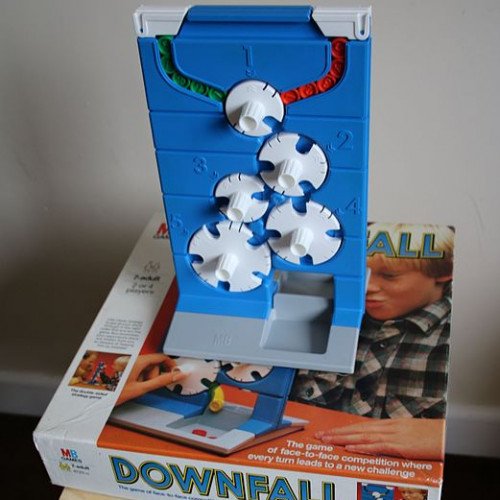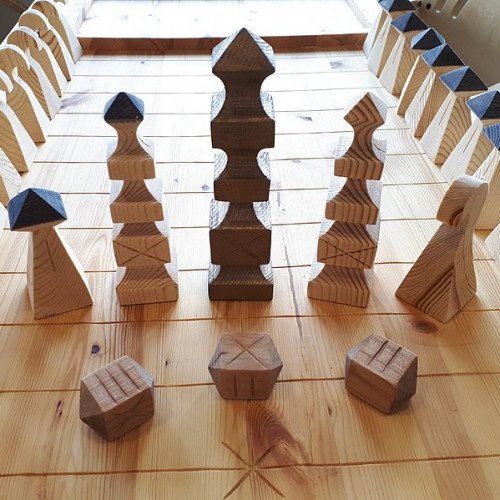DOWNFALL VS SÁHKKU

DOWNFALL
Downfall is a two-player game for players aged 7 and older, first marketed by the Milton Bradley Company in 1970. The game consists of a vertical board with five slotted dials on each side. Each player starts with ten numbered tokens or discs at the top of the board. The object of the game is to move the discs to the bottom of the board by turning the dials. Players alternate turns moving the dials and cannot move a dial that their opponent has just moved. The winner is the first player to move all of their discs into the tray at the bottom. An advanced version of the rules dictates that the discs arrive in the tray in numerical order. Since neither player can see the other's board, it is common to inadvertently advance - or hinder - the opponent's gameplay. The game rewards forward thinking and planning; players may try to "trap" their opponent into turning a dial that will advance their own disc, while trying to ensure that their own discs are not caught and dropped out of order. The game is currently available in the UK under the name New Downfall, manufactured and marketed by Hasbro. The new version follows the same rules but has a more futuristic design in red and yellow. The game's box art is parodied on the cover of Expert Knob Twiddlers, an album by Mike & Rich (Mike Paradinas & Richard D. James).
Statistics for this Xoptio

SÁHKKU
Sáhkku is a board game of the Sami people. The game is traditional among the North Sámi, Skolt Sámi, Inari Sámi and Lule Sámi but may also have been played in other parts of Sápmi. Sáhkku is a running-fight game, which means that players move their pieces along a track with the goal of eliminating the other players' pieces. Many different variants of sáhkku have been played in different parts of Sápmi. The oral transfer of the sáhkku rules between generations was largely broken off during the 1900s (see Sáhkku today). A few of the local variants have survived into our time, other local variants have been reconstructed based on a combination of memories and written sources, and for some places only fragments of the local rules are known from old documents. A sáhkku board (sáhkkufiellu, bircunfiellu or sáhkkulávdi) can traditionally be designed in a number of different ways. At its simplest, a sáhkku board has three parallel rows of short lines, and the pieces are placed on these lines. The lines are called sárgat (one sárggis) in Sámi. It is common to draw the short lines as vertically connected to each other, so that the board appears to consist of just one row of very long lines, but the game is still played as if these were three separate rows of short lines. Such boards often also have three horizontal lines intersecting the vertical lines in order to illustrate that the lines are still in practice divided into three parallel rows. Some boards feature only a central horizontal line crossing the connected vertical lines, but the game is still played as if there were three rows of short lines. A special type of sáhkku board is the so-called Návuotna board which has three rows of squares (ruvttat, lanjat) instead of lines. The central line/square of the middle row, sometimes referred to as "the Castle", is indicated by a sáhkku-symbol ("X"), sun symbol, or other ornament.